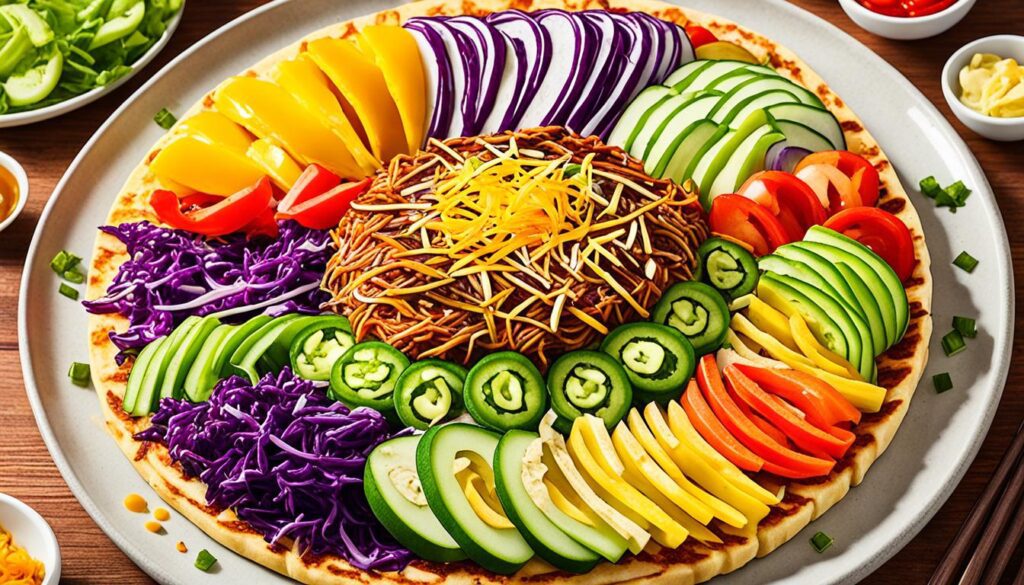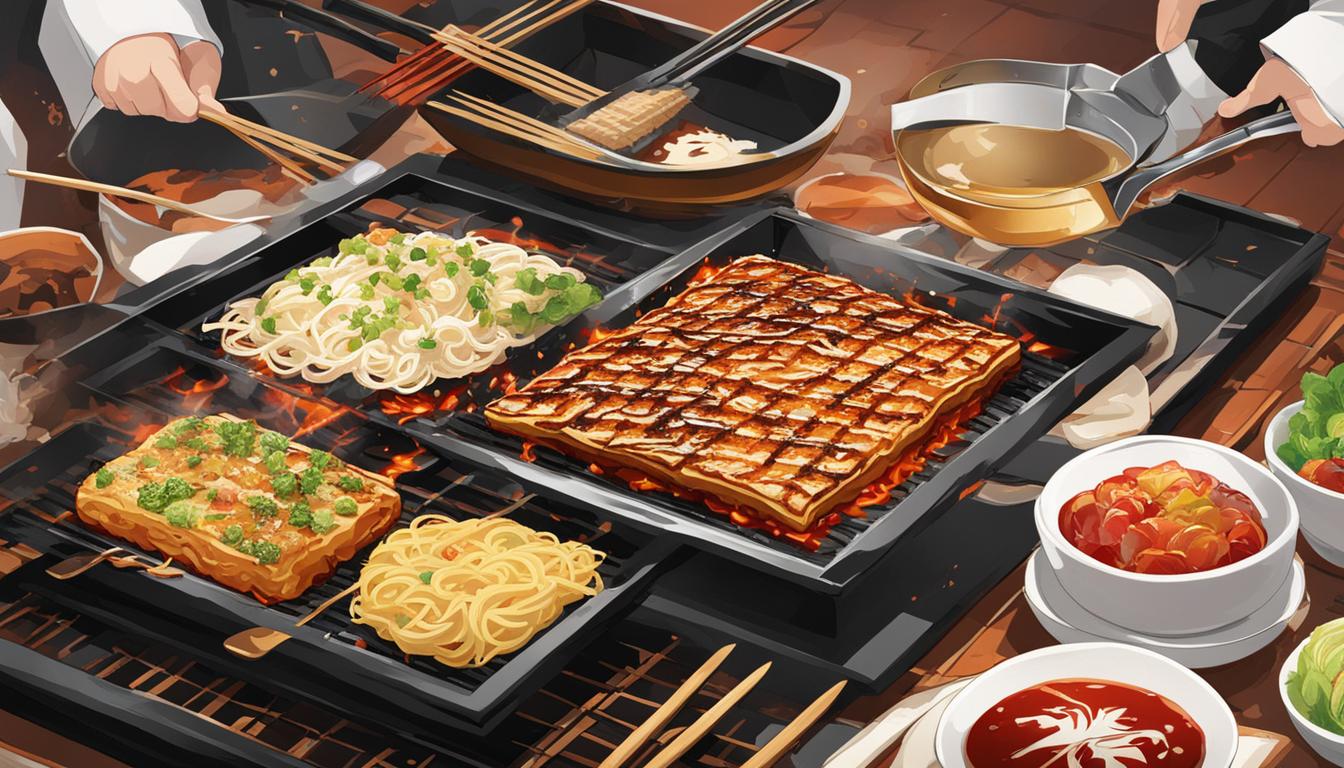Welcome to the world of okonomiyaki, a beloved Japanese dish that has captured the hearts and taste buds of people around the globe. In this article, we will explore the meaning and grammatical aspects of the word “okonomiyaki,” understand how to pronounce it, and delve into its cultural significance. So, if you’ve ever wondered what this mouthwatering dish is all about, you’re in the right place!
The Origin and History of Okonomiyaki
The origins of okonomiyaki can be traced back to several early precursor dishes in Japanese culinary history. There is evidence of a thin crêpe-like confection called “funoyaki” that dates back to the 16th century. The modern form of okonomiyaki emerged in the early 20th century after the Great Kantō earthquake and World War II, when people began cooking these pancakes using various available ingredients. Okonomiyaki became a popular and affordable dish, gaining household popularity and commercial availability.
Okonomiyaki Variations by Region
Okonomiyaki is a versatile dish that showcases unique regional variations throughout Japan. The two main styles of okonomiyaki are the Kansai style, also known as the Osaka style, and the Hiroshima style.
Kansai Style
The Kansai style of okonomiyaki is the most well-known and popular variation. The batter is made with a mixture of flour, grated nagaimo (a type of yam), dashi or water, and eggs. Shredded cabbage is a key ingredient, providing a light and crispy texture. Additional ingredients such as green onion, meat, seafood, and vegetables can be added to customize the dish to your liking. The Kansai style is known for its harmonious combination of flavors and its emphasis on simplicity.
Hiroshima Style
The Hiroshima style of okonomiyaki takes a different approach to preparation. Instead of mixing all the ingredients together in the batter, the Hiroshima style involves layering them on the griddle. The base consists of a thin layer of batter, followed by a generous amount of shredded cabbage. Pork and yakisoba noodles are then added, creating a hearty and filling dish. Toppings and sauces are applied liberally, resulting in a visually stunning and flavorful okonomiyaki.
In addition to the Kansai and Hiroshima styles, there are numerous regional variations of okonomiyaki throughout Japan. Each region puts its own spin on the dish, incorporating local ingredients and techniques. Some examples include the Tokyo style, which features a thinner batter and a sweeter sauce, and the Tsukishima style, which adds soba noodles to the batter. These regional variations allow you to experience the diverse flavors and culinary traditions of Japan.
Okonomiyaki Outside of Japan
Okonomiyaki, a popular savory pancake dish from Japan, has gained recognition and popularity beyond its home country. It can now be found in various countries outside of Japan, where it has been embraced by locals and tourists alike. Regions such as the Philippines, Taiwan, Thailand, and Indonesia offer opportunities to savor this delightful street food, often served by skilled vendors who whip up fresh batches of okonomiyaki right in front of you.
When venturing beyond the borders of Japan, you may come across okonomiyaki referred to as “Japanese pizza” or “Osaka soul food”. These terms highlight the unique flavors and cultural significance of this beloved dish. Whether you’re strolling through the bustling streets of Manila, Taipei, Bangkok, or Jakarta, you’re likely to encounter food stalls and restaurants that serve okonomiyaki, inviting you to experience a taste of Japanese cuisine in a foreign setting.
Okonomiyaki Cooking Styles
When it comes to preparing okonomiyaki, there are two main cooking styles that you’ll come across. In some restaurants, you have the opportunity to cook your own okonomiyaki on a teppan, a flat griddle. This interactive dining experience allows you to have full control over the cooking process, ensuring that your okonomiyaki is prepared exactly how you like it.
On the other hand, there are establishments where the chefs take charge of preparing the dish for you. This ensures consistent quality and presentation, allowing you to sit back, relax, and enjoy the flavors of this delicious Japanese pancake.
If you’re feeling adventurous or want to recreate the okonomiyaki experience at home, it’s also possible to make your own. All you need is a simple batter made of flour, water, eggs, and cabbage. From there, you can get creative and add your favorite ingredients and toppings to make it truly personalized.
| Cooking Style | Description |
|---|---|
| DIY Cooking | Customers cook their own okonomiyaki on a teppan in restaurants. |
| Chef’s Preparation | Restaurants have chefs who prepare the okonomiyaki dish for customers. |
| Home Cooking | Okonomiyaki can be made at home using a simple batter and your choice of ingredients. |
Whichever cooking style you choose, the end result is a savory, flavorful pancake that showcases the essence of Japanese cuisine. Enjoy the process of making your own okonomiyaki or leave it in the hands of skilled chefs for a memorable culinary experience.
In the next section, we’ll explore the various toppings and accompaniments that complement okonomiyaki and enhance its delicious flavors.
Okonomiyaki Toppings and Accompaniments

Okonomiyaki is traditionally served with a variety of toppings and accompaniments to enhance its flavor. Some common toppings include okonomiyaki sauce, aonori, katsuobushi, Japanese mayonnaise, and pickled ginger. These toppings add layers of savory, umami, and tangy flavors to the dish, creating a well-rounded culinary experience.
One of the key components that elevates the flavor of okonomiyaki is the okonomiyaki sauce. Made with Worcestershire sauce as a base, this sweet and savory condiment delivers a rich and complex taste. It complements the other ingredients in the pancake, balancing the flavors and adding a touch of tanginess.
Another essential topping is aonori, dried seaweed flakes. Aonori adds a subtle hint of saltiness and imparts a pleasant crunch to the dish. Sprinkling aonori over the okonomiyaki gives it a visually appealing green color and enhances the overall taste.
Katsuobushi, or bonito flakes, is another popular topping. These thin, dried fish flakes are known for their smoky and complex flavor profile. When the hot okonomiyaki is topped with katsuobushi, the flakes gently dance and curl due to the heat, creating a mesmerizing presentation.
Japanese mayonnaise is a creamy and tangy condiment that adds a delightful richness to the okonomiyaki. Its velvety texture and savory notes perfectly accentuate the flavors of the dish. Drizzling a generous amount of Japanese mayonnaise on top is a common practice.
Last but not least, pickled ginger provides a vibrant and refreshing contrast to the savory components of the okonomiyaki. Its tartness and slight spiciness cut through the richness of the pancake, enhancing the overall balance of flavors.
To summarize, the combination of okonomiyaki sauce, aonori, katsuobushi, Japanese mayonnaise, and pickled ginger creates a symphony of flavors in every bite of okonomiyaki. These toppings and accompaniments elevate the dish, making it a memorable and satisfying culinary experience.
Enjoying Okonomiyaki in Japan and Abroad
Okonomiyaki, with its rich history and flavorful variations, is a beloved dish that can be enjoyed both in Japan and abroad. In Japan, you can find dedicated okonomiyaki restaurants in many cities, offering a wide range of delicious options to indulge in. These establishments specialize in preparing okonomiyaki with authentic regional flavors, allowing you to savor the unique tastes of different areas.
Whether you’re in Osaka, Hiroshima, or any other city in Japan, trying okonomiyaki is a must for food enthusiasts and those seeking an authentic culinary experience. You can choose from various cooking styles, including the interactive teppan experience where you cook your own okonomiyaki or having skilled chefs prepare it for you.
Outside of Japan, okonomiyaki has gained international recognition and can be found in many countries. It offers a taste of Japanese cuisine to a global audience, delighting palates with its savory flavors and unique combinations of ingredients. In countries like the Philippines, Thailand, and Indonesia, you can often find street vendors serving up this delightful dish.
So whether you’re visiting Japan or exploring international food scenes, make sure to experience the joy of okonomiyaki. With its meaning of “how you like” and delicious blend of flavors, okonomiyaki truly embodies the essence of Japanese cuisine.

